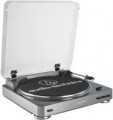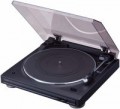Model
Model of the pickup (cartridge) supplied with the player. The pickup is one of the most important parts of any vinyl player, the quality of the received sound largely depends on its quality. Knowing the name of the model, you can find detailed data on it and determine how satisfied you are with this particular cartridge.
Output level
The signal level at the output of the pickup supplied with the player is, in fact, the power of the signal coming from the pickup to the phono stage. This parameter is necessary, first of all, in cases where the player is planned to be connected to an external phono stage: such equipment must be designed for the corresponding power of the signal coming from the pickup.
Downforce
The force of pressing the needle on the plate, which the complete pickup (cartridge) is designed for.
This force depends on the rigidity (compliance) of the needle: the greater the clamping force, the harder the cartridge, respectively, the less pliable it is. It is also believed that less pressing force wears out the record less, but it cannot be said that "light" cartridges are definitely better — there are many other nuances. So in fact, information about the pressing force of a complete pickup is needed mainly in case of its replacement. Usually, the pressing force provided by the arm of the turntable is regulated within these limits, so the new cartridge must also be rated for the same values of downforce — otherwise there is a chance that the turntable will not be able to correctly align.
Tonearm effective length
The effective length of a tonearm in set is the distance from the attachment point (axis of rotation) to the stylus.
This indicator is important primarily for rotary tonearms: the longer the length, the lower the angular error, the smaller the discrepancy between the direction of movement of the track and the longitudinal axis of the pickup (for more details, see “Type”) and the lower the level of corresponding distortion. In addition, a longer length reduces the resonant frequency and reduces the likelihood of distortion. On the other hand, a longer tonearm turns out to be heavier, which requires certain technical tricks and can also negatively affect the purity of the sound. Therefore, a large length is not always a guarantee of high quality – you should also pay attention to weight (see below).
Phono stage
A phono corrector is a specially designed preamplifier used when working with vinyl record pickups. Initially, the sound on such records is recorded with distortion of the amplitude-frequency characteristic, namely with an increase in volume from low to high frequencies; this is due to the technical features of the recording process. Accordingly, the phono corrector not only amplifies the signal to a level sufficient for feeding to the power amplifier, but also corrects the amplitude-frequency characteristic, “pulling out” the bass and reducing the volume of the HF. And
the built-in phono corrector allows you to connect the player to the power amplifier directly, without using intermediate equipment. True, in terms of characteristics, built-in preamplifiers-correctors are inferior to external ones. Therefore, some models with this function may provide
a “bypass” mode, allowing you to pass the signal bypassing the built-in phono corrector to an external, more advanced one. And there are also
vinyl players without a phono corrector at all.
Connection
—
USB B port. A connector designed to connect the player to a computer as a peripheral device. This connection is mainly used for converting vinyl records to a digital audio format such as MP3. At the same time, computer processing allows you to "clean" the recording from clicks and other extraneous interference; the necessary software for this may even be supplied in the kit.
—
Bluetooth. The presence of a built-in Bluetooth module in the design of the player. This technology is designed for direct wireless communication with other devices at a distance of up to 10 m. The capabilities of such communication may vary, depending on the supported Bluetooth protocols. The most popular use of this feature in players is to broadcast audio to wireless headphones or speakers. Such a connection may be somewhat inferior to a wired one in terms of sound quality, but it does not require fiddling with cables and selecting compatible connectors; and the difference in quality is most often unprincipled, especially considering the characteristics of the sound from vinyl. Other options for using Bluetooth are technically possible — for example, remote control from a smartphone or tablet — but they are extremely rare.
—
Audio input. The presence of an audio input in the design of the player; usually in this case it means a linear analogue audio input. In different model
...s, it can use different types of connectors — for example, 3.5 mm mini-Jack or RCA "tulips". However, regardless of the type of connector, the purpose of such an input is the same everywhere — it is designed to connect an external sound source and process this sound with the player's built-in tools. For example, you can connect a portable player to the audio input and output sound through the built-in turntable amplifier.
— Digital audio output. The presence of a digital audio output in the design of the player. Usually, this output is made in the form of an S / P-DIF connector — optical or electronic; the first option is less susceptible to interference, the second does not require special delicacy when handling the cable. This connector can be useful for connecting external audio devices with digital inputs to the player. In some cases, a digital connection is preferable to an analogue one — for example, if there are no line inputs in an external device or they are all occupied. At the same time, the digital interface requires an analogue-to-digital converter in the "turntable", and these are additional electronic circuits and a potential source of interference. Therefore, such outputs are not used in audiophile-class equipment.
— Headphone output. The presence of a separate headphone output in the design of the player. Typically, this output uses a 3.5 mm mini-Jack or 6.35 mm Jack. The first variety is found in most modern headphones, the second is more reliable and typical for professional models; both interfaces are compatible through a simple adapter. Anyway, connecting headphones can come in handy in two situations: when it is desirable to keep silence and not disturb others with music, or vice versa, when it is noisy around and the sound from the speakers would be hard to hear. Theoretically, the second use case is popular among DJs — in the overall sound, it is important to hear what exactly the turntable is playing at the moment. However, in fact, DJs prefer to connect their "ears" not to the player itself, but to external equipment. Therefore, its own headphone output is typical mainly for consumer-class models.ADC sampling rate
The sampling rate of the A/D converter installed in the player. To listen to vinyl in the usual way (cartridge — phono stage — power amplifier — acoustics), it is not necessary to convert the analogue signal coming from the pickup into digital format. This function (and, accordingly, the characteristics of the ADC) is relevant only when recording to a computer or removable media, as well as when using a digital audio output (see "Characteristics").
When digitized, analogue audio is decomposed into separate "pieces" (samples), and the data for each sample is recorded digitally. The sample rate describes how many samples there are for every second of the audio being converted; the higher it is (ceteris paribus), the closer the digital audio signal will be to the original. The most modest converters in modern turntables are capable of operating at a sampling rate of 44 (more precisely, 44.1) kHz — the quality of such a recording corresponds to an Audio CD and can already be indistinguishable from high-end vinyl. And in the most advanced, this figure reaches 48 kHz (DVD and DAT level).
ADC bit depth
The bit depth of the analogue-to-digital converter installed in the player. To listen to vinyl in the usual way (cartridge — phono stage — power amplifier — acoustics), it is not necessary to convert the analogue signal coming from the pickup into digital format. This function (and, accordingly, the characteristics of the ADC) is relevant only when recording to a computer or removable media, as well as when using a digital audio output (see "Characteristics").
When digitizing an analogue signal, it is decomposed into samples (for details, see "ADC Sampling Frequency"), and for each sample, its own signal level value is indicated. The higher the ADC bit depth, the more accurately this value will correspond to the initial signal level and the closer the digital sound will be to the original. To digitize audio as an Audio CD (which is already considered quite “audiophile”), 16 bits is enough, but in modern players this figure can be even higher — up to 24 bits.
Frequency range
The range of frequencies that the player is capable of outputting when using a standard pickup.
The wider the frequency range, the more complete the sound picture will be, the less low and/or high frequencies will remain behind the scenes. However, from a practical point of view, it does not make sense to expand the range beyond the values \u200b\u200bof 16 – 22000 Hz — it is within these limits that the human ear hears the sound (and even then not everyone). In high-end audio equipment, including turntables, there are more extensive ranges; however, such characteristics are a kind of “side effect” of high-end technology that manufacturers use for advertising purposes.
In addition, we note that an extensive frequency range is not yet a guarantee of high-quality sound: the sound picture depends on many other parameters, from the amplitude-frequency response to extraneous interference.

